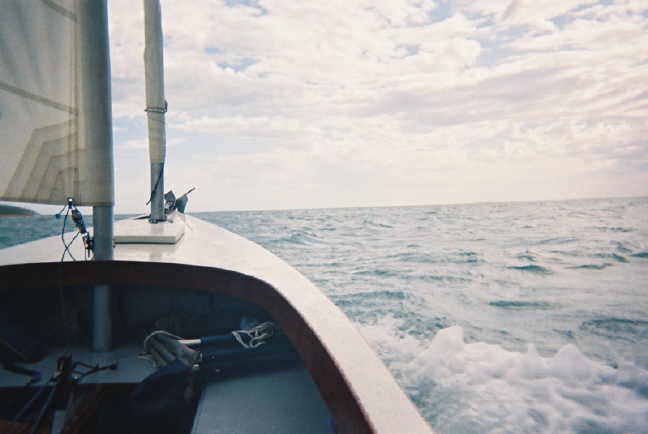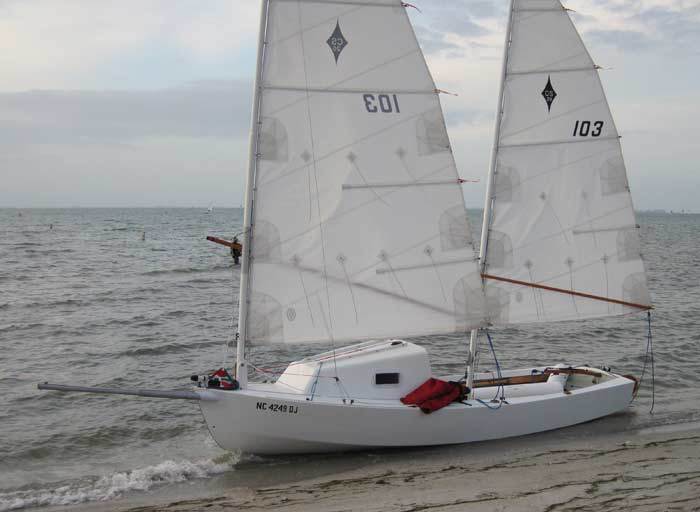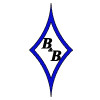Core Sound 20
Now available as a CNC kit. The first CS-20 to be built from the kit (hull #174) can be seen here. See below for pricing and details.
Be sure to checkout the Core Sound 20 Video playlist on our youtube channel.
To see more about this design check out the Core Sound 20 Builders Guide. This document is gradually updated and improved.
The Core Sound 20 was originally commissioned as a daysailer and camper sailer which could win races. Specifically, a boat which could beat the Core Sound 17 which had been gobbling up all the trophies. The boat has lived up her promise. Not long after she was officially launched in the summer of ’99, she won the grueling 2 day open water Independence Day Race. For more information: The Great Race. In spite of her energetic sailing characteristics, she is easily handled; even with our 2 1/2 year old grandson on the helm. The photo (above) was taken by the committee boat, which clocked her speed at 8 knots, with bursts to about 10 knots. Notice the rig: On this boat, all of the controls are led aft to the helmsman, allowing the boat to be reefed and un-reefed without leaving the helm. With increasing wind, we were able to lower the sails in order to lower the center of effort to reduce heeling.

Photo above from "The Great Race" Beaufort, NC. Below, David at the helm of Core Sound 20 Hull #1.

LOA………………..20′ 0″
BEAM……………… 6′ 3″
DRAFT……………. 8″ – 3′ 9″
SAIL AREA …….155 sq. ft.
BOAT WEIGHT…500 – 600 lbs
SAILING WEIGHT 1300 lbs @DWL With people and gear
Construction:
The sides are fiberglass/epoxy taped to the bottom panels just at the bow. Then the bottom panels are wired together along the keel centerline, and opened like a book, you have the sides in position and ready to wire. The hull panels are pre-engineered, so that there is no lofting, no jig or strong back required. Our “butterfly” construction technique allows easy hull assembly.


After the installation of the temporary bulkhead and transom, the sides are wired to the bottom. This boat is almost completely “stitched” and will shortly be ready for “gluing” ie. fiberglass/epoxy taping the seams. Note that the pre-attached stringer, which appears to be drooping at the bow above, align nicely when the hull is wired/folded into shape. This is the stringer which will carry the seating. Also clearly shown are the cutouts in the temporary bulkhead to take the keel batten and spaces for the chine taping to run through.

The CS20 shown below, sailing in Australia, shows the mainsail furled (This sail has a hollow cut leech and no battens) and the mizzen is stepped in the third mast position, giving the boat perfect control during the squall. The sun is back out as the worst of the squall has passed and it can be seen by the wake that she is still making good speed.



What is not included?
The centerboard blank is easy to make but can daunting to shape. The CNC centerboard is made of laminated southern yellow pine and CNC shaped to perfection. Sand out the tooling marks and you are ready to finish. See the videos below if you're making your own centerboard blank and see our shaping process via CNC as well as the process of glassing the board.
The Rudder is CNC shaped from 3/4″ (18mm) Meranti Marine Plywood. Sand, fiberglass, paint, done.
Following videos made for the Core Sound 15 but the process is identical for both the CS-17 and CS-20
Video of Centerboard Blank Lamination
Video of CNC Centerboard Shaping
Video of CNC Centerboard Finishing
Epoxy and Glass kit:
All the epoxy and glass needed to finish the boat. You don't need to buy it all at once. Epoxy thickener for making fillets and microspheres for fairing and filling the glass weave. A heavier stitched cloth is also included for the keel joint. This replaces the solid wood "keel batten" previously found in the design. The newer mk3 designs also use an all glass keel joint with a large wide fillet on the inside of the keel joint.
Mast Kit:
The Mast kit includes all of the precut 6061-T6 aluminum mast tubes for the main and mizzen mast as well as the uhmw plastic end caps and sail stops for both masts. Our custom extruded aluminum sail track and rivets are also included. The individual mast tubes are joined to each other by wrapping the masts in fiberglass to form collars and then sanding the glass to a tight fit and gluing the sections together with epoxy. Click here to watch a video from the Core Sound 15 building series on wrapping the mast tubes with glass. Click here to watch a video of the fitting process. The same process is used on all B&B masts. There is no standing rigging as both masts are free standing. Only a few pieces of hardware are attached to the mast.
Rigging kit:
Click here to see the complete hardware packing list. The rigging kit includes all hardware and lines needed to rig the boat but does not include fasteners for said hardware. These are to be sourced by the builder. 18-8 stainless nuts, bolts and screws are perfectly adequate for a trailer sailer that will not live in salt water. This is the grade stainless hardware carried by most big box stores or ace hardware. The main and mizzen rigging method is essentially identical to the Core Sound 17. A staysail kit is also available. The Core Sound 20 does not have a bowsprit although some builders have add them themselves.
How to order:
If you are ready to order the Core Sound 20 CNC kit, checkout below with the "deposit" in your cart. This will lock you into the current kit pricing and you can follow up with a call or email to us about what you would like us to include with your kit. Kits are typically complete in approximately 4-6 weeks. All of our kits are cut to order using the best materials and the careful attention to detail. We will contact you with a shipping quote when your order is ready to ship. See our shipping policy section on available options (home delivery or self pickup) you can also visit our workshop and pickup your kit directly and see where it was born.

